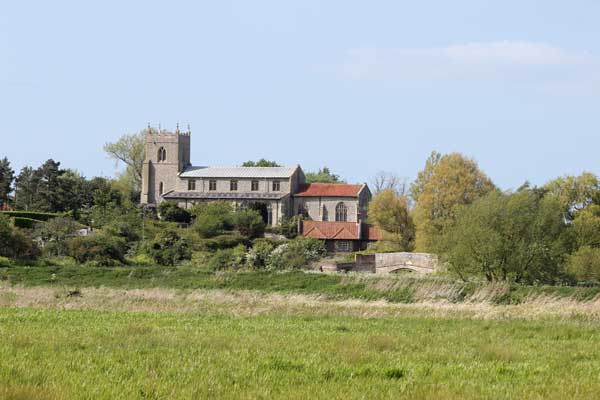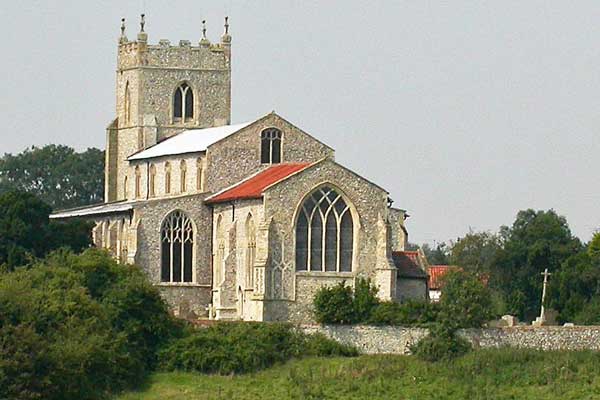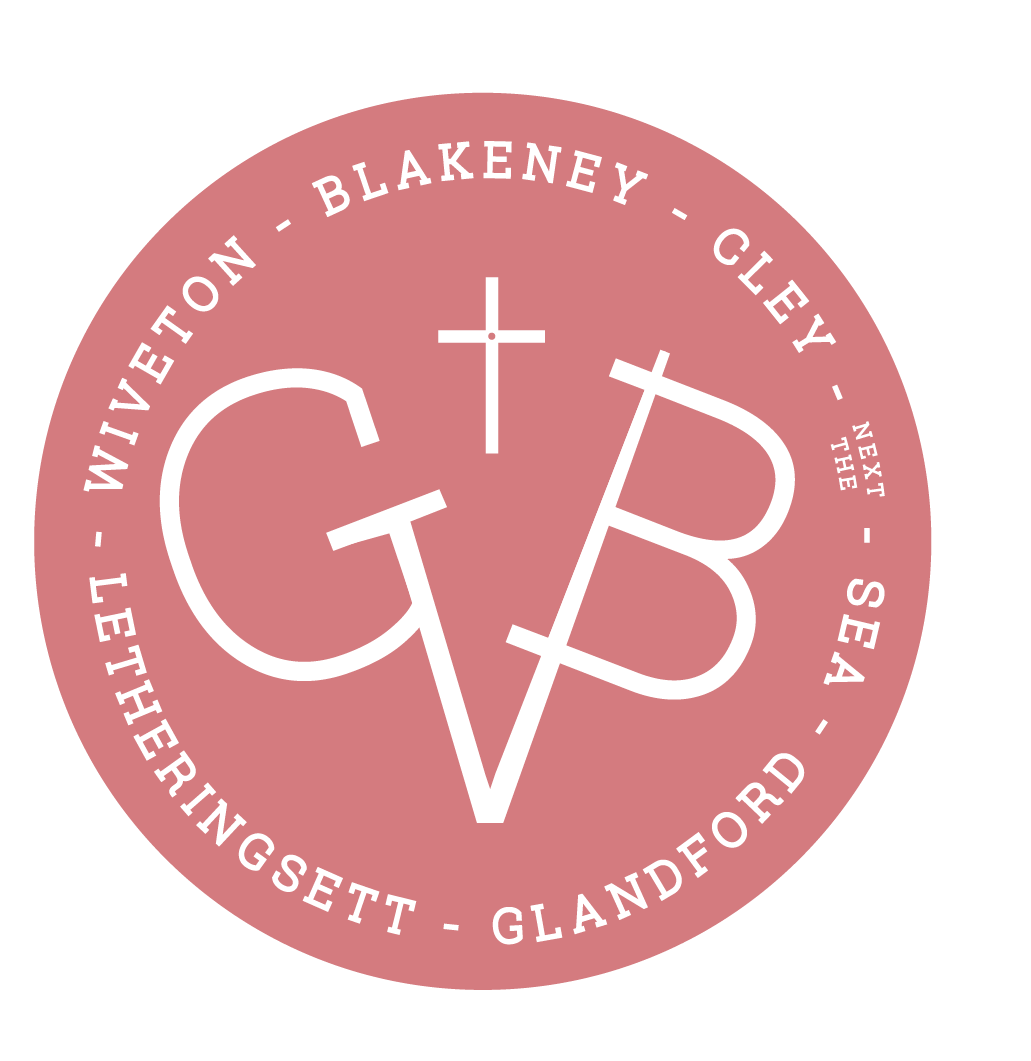Wiveton Church – Buildings & History
WIVETON, which is pronounced “Wifton” or “Wiverton” means “Wifa’s Tun” and the derivation of the name is the same as with Wivenhoe in Essex—Wifa’s “Hoh” or spur of land. Wiveton also spreads along a ridge, and before they enter the church, visitors might well stand at the east side of the churchyard and get the lie of the land.
The Estuary
The church and churchyard stand at the southern end of the village; due east is Cley which, like Wiveton, straggles along the banks of the Glaven. Both villages face one another across green meadows which were, until a century and a half ago, a tidal estuary, and both places were ports with harbour frontage. Just east of the churchyard and along the river bank to the north was Wiveton Quay, and in the Middle Ages, during the fifteenth century when the church was built, and for long afterwards, ships went from here to Continental ports. In 1575, eight ships belonged to the town; and twelve years later the port possessed four ships of a hundred tons or over. There was considerable trade with the Low Countries, Scandinavia and Iceland, though by the seventeenth century coasting seems to have become more important than the foreign trade.
But early in the seventeenth century, Sir Cornelius Vermuyden’s success in draining the Fens inspired the Calthorpe family to reclaim part of their coastal estates in Norfolk, with the assistance of another Dutch engineer, Van Hasedunck. During the seventeen thirties and forties the marshes eastward around Salthouse were embanked to the ruin of that town as a port; and with the making of a bank across the estuary—on the site of the present coast road between Cley and Blakeney—the merchants of Cley and Wiveton, especially Wiveton, saw the same fate awaiting them.
On January 31st, 1638, an “Admirall Court” was held at Cley, to which witnesses (many of them from Wiveton) were called in support of the claim by the townsmen that their livelihood would be destroyed. A petition was made to the King to restrain Sir Henry Calthorpe of Cockthorpe, and his son Philip Calthorpe, from embanking their saltings at Blakeney and Wiveton. But though the petition was successful and the bank demolished, enough seems to have been done to impede the flow of the tides to the port of Wiveton, even though ships could pass up the estuary to the Cley quays on the other side of the river.
From this time the maritime trade of Wiveton began to decline, and though small ships were able to come up to the Cley Quay, near the windmill on the other side of the river, until the early years of the present century, Wiveton ceased to be a port and dwindled into the small village of under two hundred inhabitants that it is today.
In 1823 the Enclosure Act completed what the Calthorpes had begun, and a new embankment was made and the “new road” constructed parallel to it—the modern coast road. Until that time the tides had flowed up the estuary under the high arch of the fourteenth century Wiveton Bridge east of the church, and up to Glandford.


Wiveton Church
Wiveton Church was entirely rebuilt during the fifteenth century at the time when the port was most prosperous, and it is one of the most splendid buildings of the period in the district. Of the earlier church little remains. The tower, with its right-angle buttresses and with its lancet windows in the lower stages, represents all that is left of the earlier work, which was brought into line with the new building by the addition of a top belfry stage and parapet. The pinnacles at the corners, in the shape of urns, belong to the seventeenth or early eighteenth century.
Church History
Unlike many mediaeval church buildings, St. Mary’s, Wiveton, seems to have been built all at one time, and it presents a very good example of the fifteenth century “Perpendicular” style, as that style is represented in East Anglia. A lofty Nave with very beautiful slender columns and arcades rising to a clerestory and arch braced roofs in the Nave and Aisles. The Aisle Windows, it will be noticed, are also arcaded, as is often the case with fifteenth century churches in East Anglia, and the sills have been lowered for seats.
Across the Chancel Arch was the Rood Screen, remains of which have been worked up into a tower screen set into the very fine fifteenth century Tower Arch. The Rood Loft and Rood Beam above the screen was lighted by the window in the east wall of the Nave above the Chancel Arch, and the Loft was reached by a stair, to which there was access through a doorway at the east end of the North Aisle, and by another doorway (now blocked) in the north wall of the Chancel. A double entrance to the Rood Stair like this is very unusual, but it can be seen also in the church at Cley.
At the east end of the aisles were Altars, the piscinas for which remain. As St. Mary’s Church, the high altar would be dedicated to our Lady; and the Archdeacon of Norwich’s Visitation Return of 1368 makes it clear that the other altars were dedicated to St. John and St. Thomas. Dedications which were evidently allowed to remain in the new aisles of the fifteenth century church. By his will, dated 1518, James Steele, of Wiveton, left a legacy to the repair of the Lady Chapel. Some authorities refer to this as being a separate building in the churchyard, or near Wiveton Bridge, but all traces of it have disappeared.
In the Chancel, the windows to the north (now blocked up) and to the south, are similar in style to those in the aisles, and there is a very fine East Window with wide interlacing tracery On the exterior of the east wall of the Chancel, around the parapet of the Tower, and in other parts of the church are designs in flint flush work. The original Sacristy remains on the north side of the Chancel, and there are two fifteenth century Porches on the north and south.
Throughout the nineteenth century it received a number of careful restorations. In 1809 the old bells were recast and two new ones added by William Dobson, bell-founder, of Downham Market, to make a ring of six with the following inscriptions: —
Treble: ”Let us sing praises unto the Lord on high.”
2: “William Dobson fecit Anno Domini 1809.”
3: “Fear God and honour the King.”
4: “Let us lift up our voices with joy.”
5: “William Dobson Founder Downham Norfolk 1809.”
Tenor: “Thomas Crofts and William Gowen Churchwardens 1809.”
The tenor weighs 12 cwt, and the whole is a beautifully toned ring and the only one in working order for many miles around.
In 1849 came the existing oak Pulpit and Box Pews, which unfortunately enclose the bases of the pillars. In 1864 the whole building was thoroughly restored, and again in 1874. The Choir Stalls were given by Sir Alfred Jodrell in 1912, in memory of the Rev. J. G. B. Parmien.

